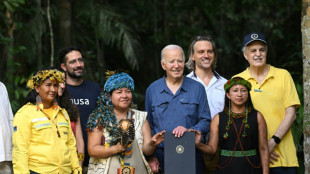
-
 Rio under high security for G20 summit
Rio under high security for G20 summit
-
G20 leaders to grapple with climate, taxes, Trump comeback

-
 Hopes set on G20 spurring deadlocked UN climate talks
Hopes set on G20 spurring deadlocked UN climate talks
-
Gabon early results show voters back new constitution

-
 Child abuse police arrest star Australian broadcaster
Child abuse police arrest star Australian broadcaster
-
Disgraced Singapore oil tycoon to be sentenced for fraud

-
 Stray dogs in Giza become tourist draw after 'pyramid puppy' sensation
Stray dogs in Giza become tourist draw after 'pyramid puppy' sensation
-
UN Security Council to weigh call for immediate Sudan ceasefire

-
 Is AI's meteoric rise beginning to slow?
Is AI's meteoric rise beginning to slow?
-
Israeli strikes on Beirut kill six, including Hezbollah official

-
 Rain wipes out England's final T20 in West Indies
Rain wipes out England's final T20 in West Indies
-
US speaker opposes calls to release ethics report on Trump's AG pick

-
 McDonald's feast undercuts Trump health pledge
McDonald's feast undercuts Trump health pledge
-
Thousands march through Athens to mark student uprising

-
 NBA fines Hornets' Ball, T-Wolves' Edwards, Bucks coach Rivers
NBA fines Hornets' Ball, T-Wolves' Edwards, Bucks coach Rivers
-
China's Xi says to 'enhance' ties with Brazil as arrives for G20: state media

-
 Bills snap nine-game Chiefs win streak to spoil perfect NFL start
Bills snap nine-game Chiefs win streak to spoil perfect NFL start
-
Biden answers missile pleas from Ukraine as clock ticks down

-
 Senegal ruling party claims 'large victory' in elections
Senegal ruling party claims 'large victory' in elections
-
Dutch plan 'nice adios' for Nadal at Davis Cup retirement party

-
 Trump meets PGA boss and Saudi PIF head amid deal talks: report
Trump meets PGA boss and Saudi PIF head amid deal talks: report
-
UN chief urges G20 'leadership' on stalled climate talks

-
 Steelers edge Ravens, Lions maul Jaguars
Steelers edge Ravens, Lions maul Jaguars
-
No.1 Korda wins LPGA Annika for seventh title of the season

-
 Biden touts climate legacy in landmark Amazon visit
Biden touts climate legacy in landmark Amazon visit
-
England secure Nations League promotion, France beat Italy

-
 Star power fails to perk up France's premiere wine auction
Star power fails to perk up France's premiere wine auction
-
Rabiot brace fires France past Italy and top of Nations League group

-
 Carsley relieved to sign off with Nations League promotion for England
Carsley relieved to sign off with Nations League promotion for England
-
Sinner says room to improve in 2025 after home ATP Finals triumph

-
 Senegal counts votes as new leaders eye parliamentary win
Senegal counts votes as new leaders eye parliamentary win
-
Biden clears Ukraine for long-range missile strikes inside Russia

-
 Lebanon says second Israeli strike on central Beirut kills two
Lebanon says second Israeli strike on central Beirut kills two
-
Puerto Rico's Campos wins first PGA title at Bermuda

-
 Harwood-Bellis risks wedding wrath from Keane after England goal
Harwood-Bellis risks wedding wrath from Keane after England goal
-
'Nobody can reverse' US progress on clean energy: Biden

-
 NBA issues fines to Hornets guard Ball, T-Wolves guard Anthony
NBA issues fines to Hornets guard Ball, T-Wolves guard Anthony
-
Biden allows Ukraine to strike Russia with long-range missiles: US official

-
 Britain dump out holders Canada to reach BJK Cup semi-finals
Britain dump out holders Canada to reach BJK Cup semi-finals
-
Biden clears Ukraine for missile strikes inside Russia

-
 Ukrainians brave arduous journeys to Russian-occupied homeland
Ukrainians brave arduous journeys to Russian-occupied homeland
-
Australia not focusing on Grand Slam sweep after thrashing Wales

-
 Wales's rugby woes -- three talking points
Wales's rugby woes -- three talking points
-
Jannik Sinner, the atypical Italian star on top of the tennis world

-
 'Devil is in the details,' EU chief says of S.America trade deal
'Devil is in the details,' EU chief says of S.America trade deal
-
Kusal Mendis defies injury as Sri Lanka beat New Zealand to clinch ODI series

-
 Gatland would back change after Australia condemn Wales to record defeat
Gatland would back change after Australia condemn Wales to record defeat
-
England rout Ireland to earn Nations League promotion in Carsley farewell

-
 England secure Nations League promotion, Haaland inspires Norway
England secure Nations League promotion, Haaland inspires Norway
-
Sinner sweeps past Fritz to win ATP Finals


Five things to watch for at COP28 climate talks
Deadly floods in the Horn of Africa. Summer wildfires that ravaged Canadian forests. Global temperature records unprecedented in the history of humanity.
Environmental activists say there's no doubt anymore that urgent collective action is needed to preserve a livable planet. As the COP28 UN climate talks begin in Dubai on Thursday, here are five things to watch out for.
- The energy transition -
All eyes are on the language leaders will adopt regarding the transition from fossil fuels to renewable energy -- crucial to limiting long-term warming to 1.5 degrees Celsius as envisaged under the Paris Agreement.
At COP26 in Glasgow, in 2021, countries agreed to a "phasedown" of "unabated coal power." Since then, momentum has been building among governments and activists to extend similar ideas to oil and gas, though the exact phrasing will have to be hammered out.
Expectations are high for voluntary pledges on tripling renewable energy capacity by 2030, a goal endorsed by the United States and China in a recent climate statement, as well as doubling the annual rate of energy efficiency improvements.
Ideally, the commitments should come in the form of an official response to the "Global Stocktake," a damning report card published in September that highlighted how little the world has done to confront the crisis.
- Making 'loss and damage' a reality -
A major breakthrough at COP27 in Sharm El-Sheikh, Egypt, was an agreement in principle to compensate climate-vulnerable countries that are least responsible for greenhouse gas emissions and facing multiplying severe weather impacts.
But operationalizing a new fund has proven complicated, with negotiations dragging on for over a year. Among questions that had to be answered: will all countries pay, or just the rich? Who will be the recipients? Where would the fund be housed?
A fragile agreement was reached in early November, and COP28 president Sultan Ahmed Al Jaber told AFP in a recent interview he hoped a decision would be adopted early on in the conference.
- The climate financing gap -
Expert groups believe the world needs in excess of $3 trillion in annual climate-related flows by the year 2030 to keep climate goals alive -- but so far developing countries have fallen well short, both in terms of accelerating decarbonization, known as mitigation, and building resilience to climate impacts, known as adaptation.
In 2009, richer countries promised to reach $100 billion annually in funding for these priorities by 2020 -- a goal finally met last year, according to an OECD report earlier this month.
COP28 is expected to lay the groundwork for a new financing goal to succeed the old $100 billion target, though parties aren't required to reach a decision this year.
It could also provide an opportunity to better define and operationalize clause 2.1(c) of the Paris agreement, which called for "making finance flows consistent with a pathway towards low greenhouse gas (GHG) emissions and climate-resilient development."
- Methane and food systems -
Atmospheric methane is the second largest contributor to climate change, but has received relatively little attention compared to carbon dioxide, despite its potent warming impact.
China, the United States and the UAE are set to jointly hold a methane and non-CO2 greenhouse gasses summit at the talks, where there might be a strengthening of a 2021 "Global Methane Pledge" to reduce emissions by 30 percent by 2030.
COP28 will also be the first such conference to have a major focus on food systems, responsible for a third of manmade greenhouse gasses, with severe weather and droughts also in turn threatening food production and transport.
Another first: a summit featuring hundreds of "subnational" leaders such as mayors and governors.
Around 70 percent of the world's people are expected to call cities home by the year 2050, and increasing their participation in the climate fight is seen as vital, especially when national governments stall progress.
R.Garcia--AT


